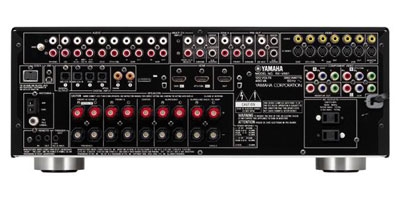Yamaha RX-V661 A/V Receiver Page 2

| The Short Form |
| Price $550 / yamaha.com/yec / 800-492-6242 |
| Snapshot |
| A solid performer with ample power, above-average DSP surround, and XM and iPod expandability. |
| Plus |
| •Very good sound and video quality •Solid power and dynamics •Extensive DSP surround modes with good performance •XM Satellite Radio and iPod integration options available |
| Minus |
| •No HDMI or upscaled onscreen displays •Questionable auto-setup results |
| Key Features |
| •90 watts x 7 channels •2 HDMI inputs •Converts composite- and S-video to component •XM-ready •Accepts Yamaha iPod dock •Automatic speaker setup and calibration/EQ via supplied mike •Zone-2 audio-only line outs •Back surround channels assignable to Zone 2 or front-presence speaker outputs •Audio Delay function for adjusting lip-sync (0-160 ms) •17.1 x 6.8 x 15.5 in / 25.5 lb |
| Test Bench |
| Yamaha's RX-V661 yielded some very good numbers, including superbly low noise and distortion through its analog multichannel inputs. The digital inputs' S/N, linearity, and noise-modulation results together suggest a digital-to-analog conversion error involving the magnitude of the least-significant bit. But this was not enough to induce any audible effects on our several dithered-noise listening signals, even over headphones at reference-plus levels. Full Lab Results |
Yamaha has been known for its proprietary DSP surround modes since the earliest days of multichannel sound - and most are more-than-typically listenable. As usual, the company has endowed the RX-V661 with a much broader-than-average range of options. In addition to the standard Dolby Digital and PLIIx and DTS/Neo:6 decodings, the RX-V661 includes a dozen-plus DSP-conjured concert halls, music clubs, and movie-theater environments under Yamaha's "Cinema-DSP" and "HiFi-DSP" rubrics. These are of varying utility, but since all include adjustability of at least a couple of basic parameters such as DSP level and initial-delay density, one or another can usually be made to sound quite natural, or at least to taste, with whatever style of music.
There's also an "Enhancer" mode that is said to compensate for the inherent "flattened complexity" and "loss of high-frequency fidelity" in data-compressed sources such as MP3s (or satellite radio). While I clearly noted the difference on engaging the Enhancer, I'm bound to say that I found its effect in the treble range to make massed strings, for one example, sound subtly harsh. Consequently, I preferred to take my perceptual-codec medicine straight up. (Interestingly, I found that engaging XM's "Neural" decoding, a virtual-surround process that's also onboard, to induce a very similar result.)
But even without any of its extra processing activated, the RX-V661 produced consistently good musical sound. I had recorded on my DVR a PBS Great Performances program of Daniel Barenboim playing selected Beethoven piano sonatas (from a 2005 concert cycle at the Berlin Staatsoper), with a no-nonsense, natural-sounding 5.1 mix. (It helps that I admire his straightforward, largely quirk-free interpretations, too.) Straight Dolby Digital sounded great, with a fairly close-in hall ambience and excellent preservation of both the piano attack and the woody, resonant tone. Selecting among Yamaha's "Classical" DSP settings, which include a choice of two halls and a "Chamber" mode, was great fun and surprisingly nondestructive. But such ambience processing necessarily effects tonal coloring, however subtly, and I ultimately preferred the straight Dolby Digital.
HANDS-ON The RX-V661's ergonomics and operation were largely unexceptional. This is a good thing - far better than being exceptionally confusing or exceptionally annoying, which is all too often the case. The supplied remote control struck me as a bit old-fashioned (with no display or backlighting), but it's logically laid out and easily usable, with a good variety of key shapes, sizes, and colors as well as larger/brighter graphics in key sections. The Yamaha's onscreen displays, mostly used only during setup, are boring old text, which still communicates just fine but also feels a little dated by today's higher-end standards. The full-screen readout of XM channel and program info is nice, but you have to key Enter each time to override the onscreen's "timeout"; otherwise, it goes away. Also, the displays appear on the RX-V661's component-video but not its HDMI output, necessitating running two video cables to your TV if you want to use the HDMI - one for the menus, one for watching content - and requiring you to switch inputs to go back and forth, which gets old fast. The menus are also 480i-only, which results in a further irritating wait while the screen re-syncs to your current viewing resolution every time it comes up or down. Admittedly, this is true of most receivers save a few flagship models, but it's no less annoying if you spend a lot of time in the menus.
The RX-V661 transcodes video signals on its composite- and S-video inputs to its component-video output, but the only signals that come out HDMI are those that go in HDMI. These are HDMI 1.2 inputs, which route digital audio into the receiver for a single-cable connection from the source, and they worked fine in this capacity. They also nicely passed HD video up to 1080i in my setup, though I lacked a 1080p-capable screen to confirm the claimed 1080p pass-through.
BOTTOM LINE Here's a quietly competent receiver, one that makes intelligent choices of what to include and what to leave off to hit its moderate price point. Fine fundamental sound, consistently above-average DSP surround, and basic but useful HDMI connections support solid power and usability. Sure, its auto-cal results should probably be verified - though I do that with every new component, including $10,000 pre/pros. But buyers whose budgets rein them in well short of "high-end" territory need not feel shortchanged: The Yamaha RX-V661 A/V receiver proves that excellent performance is still a sensible goal.
Full Lab Results Test Reports RSS Feed More Test Reports Back to Homepage What's New on S&V
- Log in or register to post comments




















































